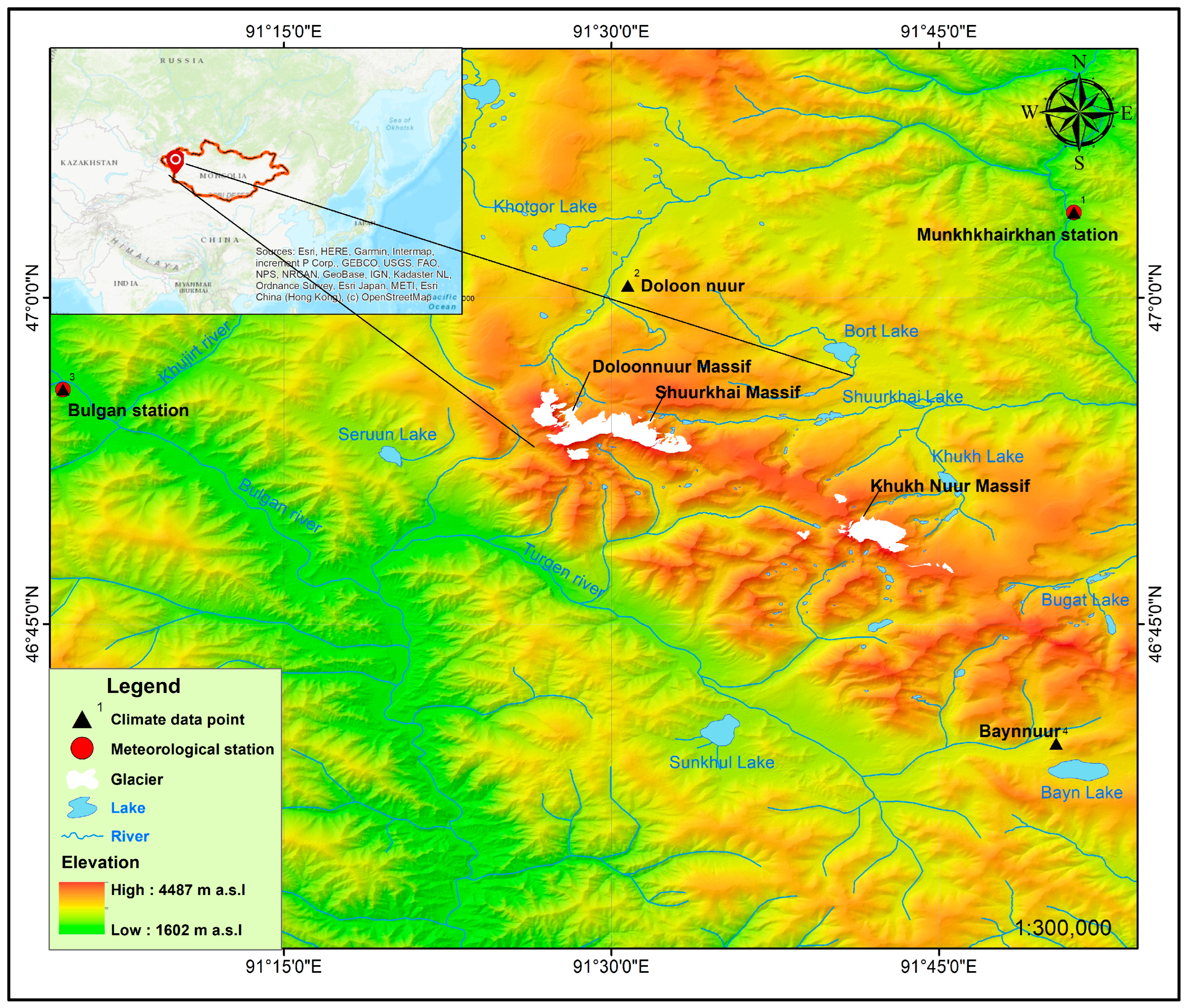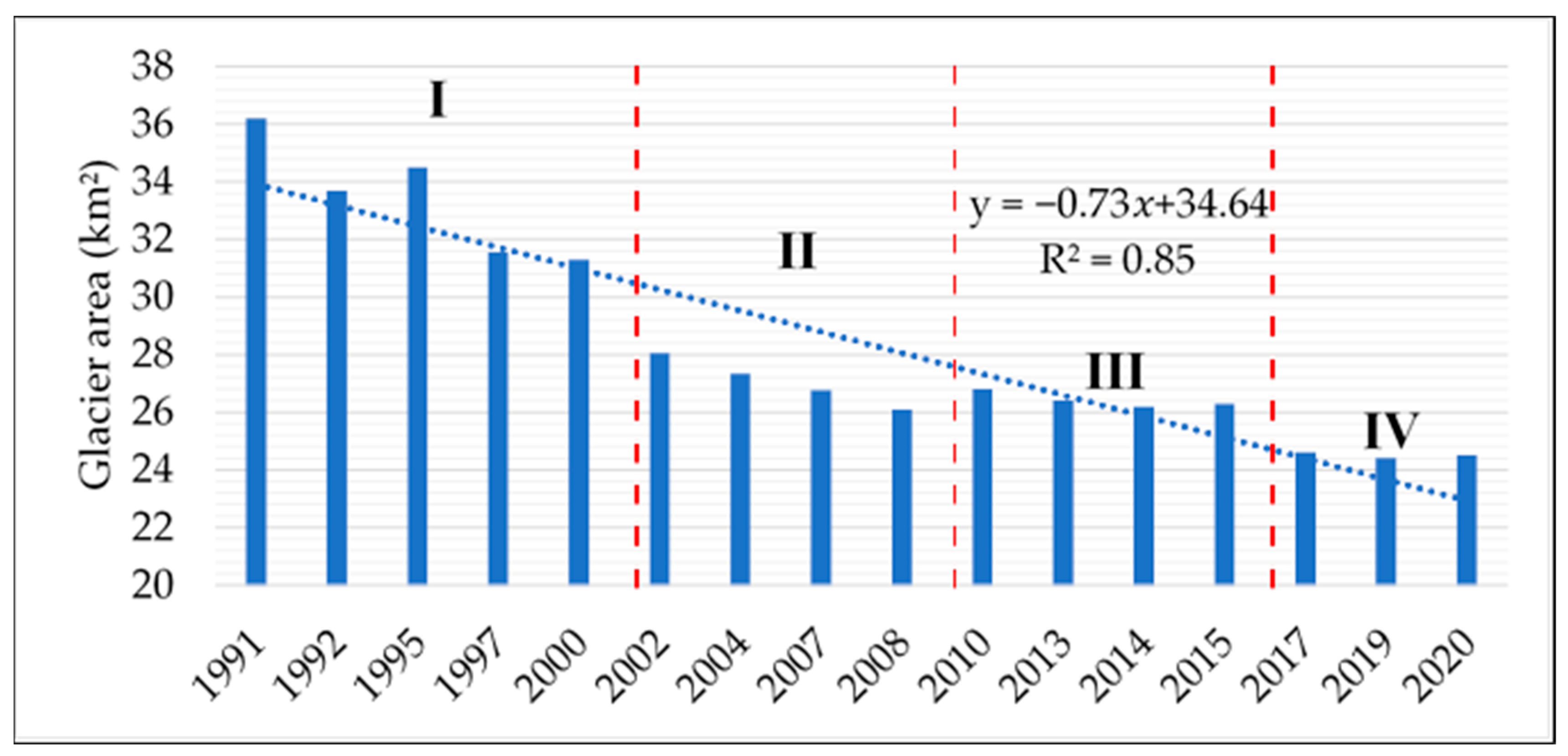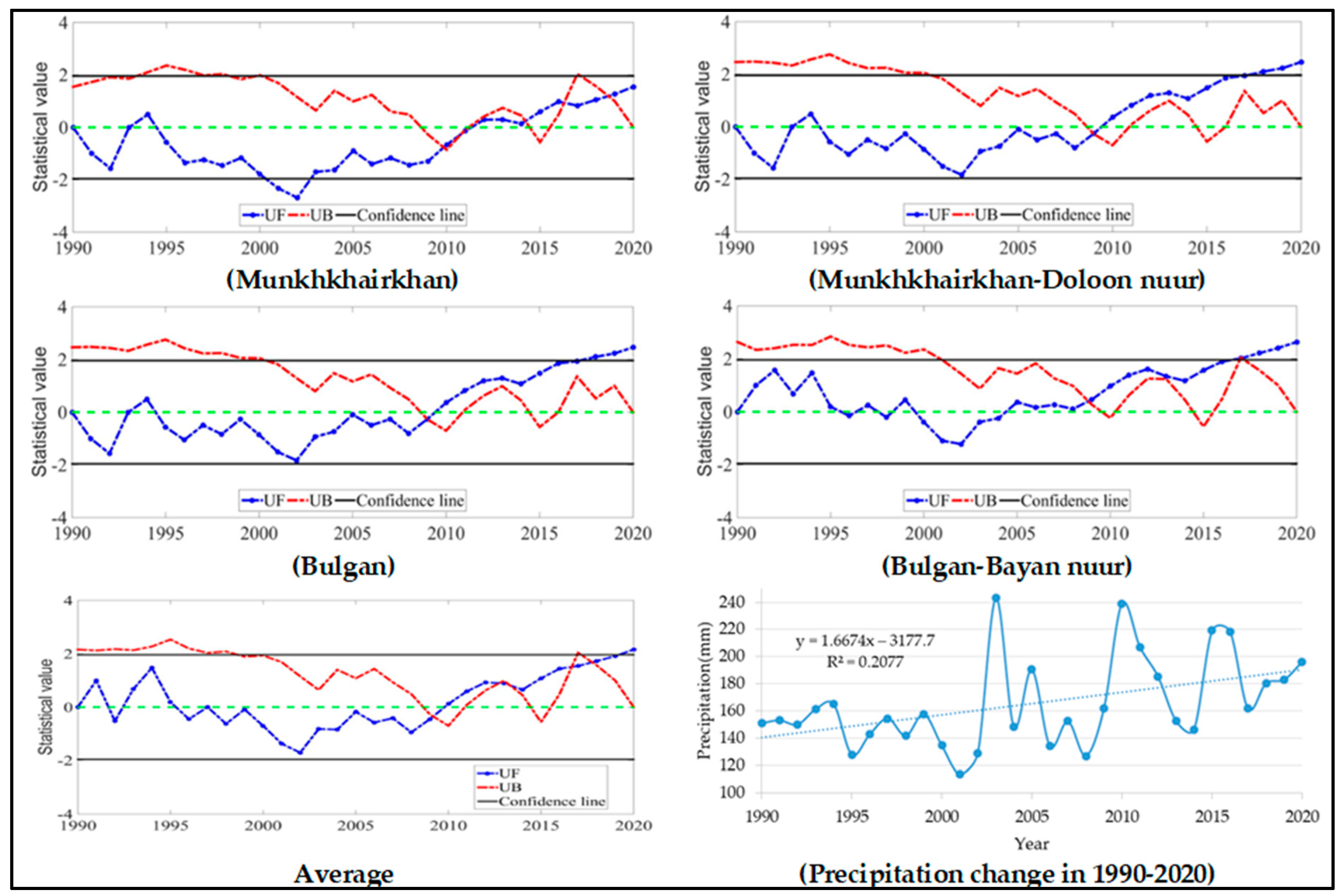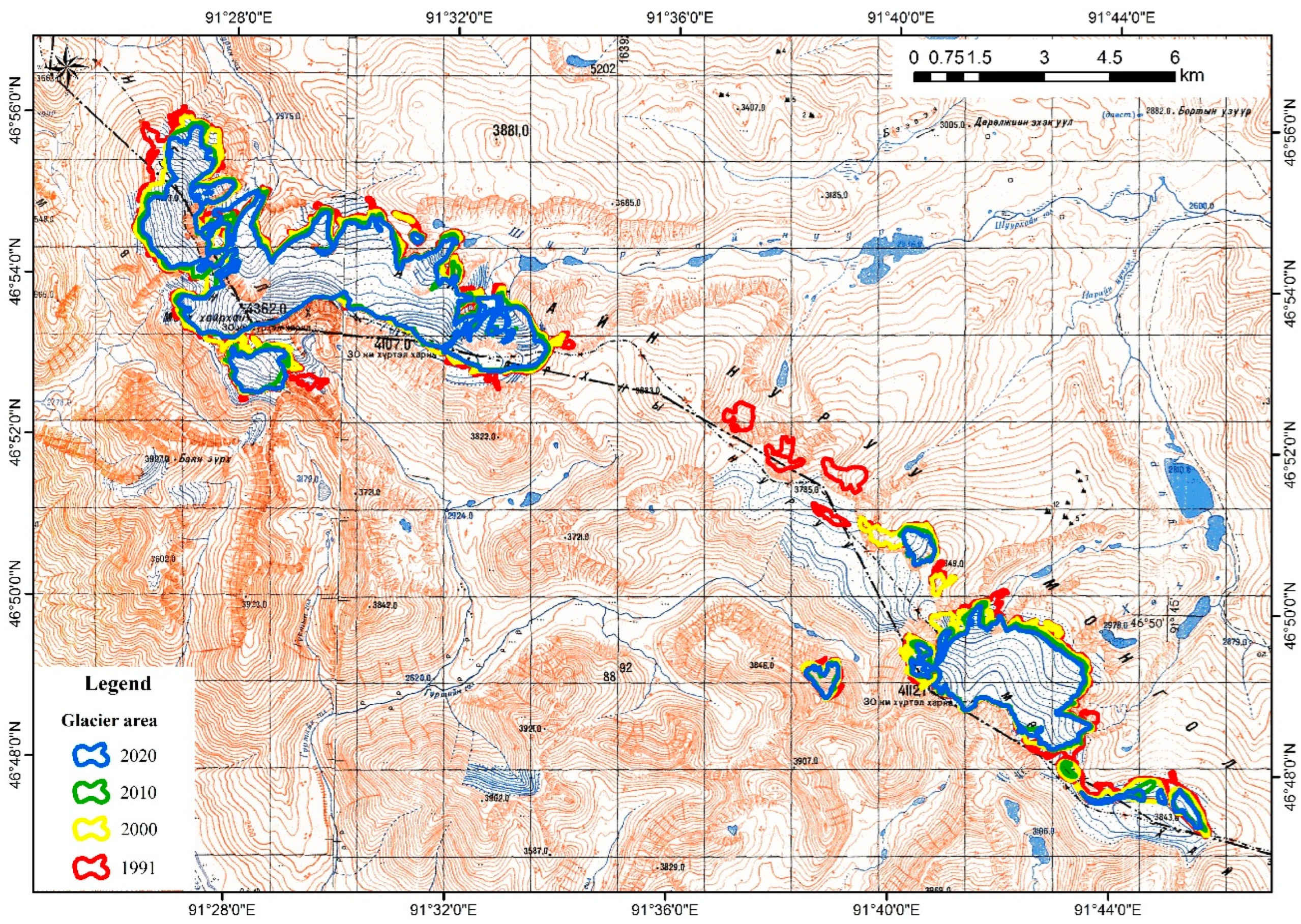Relationship between Dynamics of Modern Glaciers of the Mt. Munkhkhairkhan (Mongolian Altai) and Climate
Abstract
1. Introduction
2. Materials and Methods
2.1. Study Area
2.2. Data Source
2.2.1. Meteorological Data
2.2.2. Satellite Data
2.3. Methodology
2.3.1. Mann–Kendall (MK) Test
2.3.2. Innovative Trend Analysis Method
2.3.3. Sen’s Slope Estimator Test
2.3.4. Methodology to Calculate Glacial Area Changes
3. Results
3.1. Glacial Dynamics
- I.
- 1990–2000: The first-decade glacier melting was intense (0.4 km2 per year). The total area of glaciers decreased from 36.2 to 31.3 km2—4.9 km2/10 years.
- II.
- 2000–2010: A period of steadily increasing glacier melting and decreasing glacier area. Compared to 2008, there was a sharp decrease in area in 2010, but there was a period with a steady decrease up to 2002 (31.3–28.5 km2). Over 10 years the glacier area decreased by 4.5 km2 (0.45 km2 per year).
- III.
- 2010–2015: Glacier area changes were relatively stable, with low glacier melting (0.3 km2 per year). The period 2010–2014 corresponds to a period of increased precipitation and the greatest decrease in air temperature (Figure 5). In 2008, the rainfall was 126.8 mm, and in 2010, it almost doubled to 231.9 mm; this situation was maintained until 2015. However, the air temperature dropped sharply from −3.2 °C to −5.52 °C, and the average temperature was −3.3 °C until 2015 (Figure 5).
- IV.
- 2015–2020: Glacier area changes from 2015 to 2017 showed a dramatic reduction (26.3–24.2 km2), but from 2017–2020 was relatively stable (24.6–24.5 km2; 0.1 km2 per year). The period 2010–2014 corresponds to the period of increased precipitation and the greatest decrease in air temperature (Figure 5). In 2008, the rainfall was 126.8 mm, and in 2010, it almost doubled to 231.9 mm; this situation was maintained until 2015. However, the air temperature dropped sharply from −3.2 °C to −5.52 °C, and the average temperature was −3.3 °C until 2015 (Figure 5).
3.2. Air Temperature Analysis
3.3. Precipitation Analysis
3.4. Warming and Glacier Melting
4. Discussion
5. Conclusions
Author Contributions
Funding
Data Availability Statement
Acknowledgments
Conflicts of Interest
References
- Cantonati, M.; Poikane, S.; Pringle, C.M.; Stevens, L.E.; Turak, E.; Heino, J.; Richardson, J.S.; Bolpagni, R.; Borrini, A.; Cid, N.; et al. Characteristics, Main Impacts, and Stewardship of Natural and Artificial Freshwater Environments: Consequences for Biodiversity Conservation. Water 2020, 12, 260. [Google Scholar] [CrossRef][Green Version]
- Bantcev, D.V.; Ganyushkin, D.A.; Chistyakov, K.V.; Volkov, I.V.; Ekaykin, A.A.; Veres, A.N.; Tokarev, I.V.; Shtykova, N.B.; Andreeva, T.A. The Components of the Glacial Runoff of the Tsambagarav Massif from Stable Water Isotope Data. Geosciences 2019, 9, 297. [Google Scholar] [CrossRef][Green Version]
- Harrison, S.; Kargel, J.S.; Huggel, C.; Reynolds, J.; Shugar, D.H.; Betts, R.A.; Emmer, A.; Glasser, N.; Haritashya, U.K.; Klimeš, J.; et al. Climate change and the global pattern of moraine-dammed glacial lake outburst floods. Cryosphere 2018, 12, 1195–1209. [Google Scholar] [CrossRef][Green Version]
- Li, X.; Zhang, L.; Yang, G.; Li, H.; He, B.; Chen, Y.; Tang, X. Impacts of human activities and climate change on the water environment of Lake Poyang Basin, China. Geoenviron. Disasters 2015, 2, 22. [Google Scholar] [CrossRef][Green Version]
- Dorjsuren, B.; Yan, D.; Wang, H.; Chonokhuu, S.; Enkhbold, A.; Yiran, X.; Girma, A.; Gedefaw, M.; Abiyu, A. Observed Trends of Climate and River Discharge in Mongolia’s Selenga Sub-Basin of the Lake Baikal Basin. Water 2018, 10, 1436. [Google Scholar] [CrossRef][Green Version]
- Xenarios, S.; Gafurov, A.; Schmidt-Vogt, D.; Sehring, J.; Manandhar, S.; Hergarten, C.; Shigaeva, J.; Foggin, M. Climate change and adaptation of mountain societies in Central Asia: Uncertainties, knowledge gaps, and data constraints. Reg. Environ. Chang. 2019, 19, 1339–1352. [Google Scholar] [CrossRef]
- Abuduwaili, J.; Issanova, G.; Saparov, G. Water Resources and Impact of Climate Change on Water Resources in Central Asia. In Hydrology and Limnology of Central Asia; Springer: Singapore, 2019; pp. 1–9. [Google Scholar] [CrossRef]
- Walther, M.; Dashtseren, A.; Kamp, U.; Temujin, K.; Meixner, F.; Pan, C.G.; Gansukh, Y. Glaciers, Permafrost and Lake Levels at the Tsengel Khairkhan Massif, Mongolian Altai, During the Late Pleistocene and Holocene. Geosciences 2017, 7, 73. [Google Scholar] [CrossRef][Green Version]
- Orkhonselenge, A.; Harbor, J.M. Impacts of modern glacier changes on surface water resources in western and northern Mongolia. J. Water Resour. Prot. 2018, 10, 559. [Google Scholar] [CrossRef][Green Version]
- Kamp, U.; Pan, C.G. Inventory of glaciers in mongolia, derived from landsat imagery from 1989 to 2011. Geogr. Ann. Ser. A Phys. Geogr. 2015, 97, 653–669. [Google Scholar] [CrossRef]
- Chen, Y.; Zhang, X.; Fang, G.; Li, Z.; Wang, F.; Qin, J.; Sun, F. Potential risks and challenges of climate change in the arid region of northwestern China. Reg. Sustain. 2020, 1, 20–30. [Google Scholar] [CrossRef]
- Hock, R.; Rasul, G.; Adler, C.; Cáceres, B.; Gruber, S.; Hirabayashi, Y.; Jackson, M.; Kääb, A.; Kang, S.; Kutuzov, S. High Mountain areas. In IPCC Special Report on the Ocean and Cryosphere in a Changing Climate; Pörtner, H.-O., Roberts, D.C., Masson-Delmotte, V., Zhai, P., Tignor, M., Poloczanska, E., Mintenbeck, K., Alegría, A., Nicolai, M., Okem, A., et al., Eds.; Cambridge University Press: Cambridge, UK; New York, NY, USA, 2019; pp. 131–202. [Google Scholar]
- Plyusnin, V.M.; Kitov, A.D.; Ivanov, E.N.; Sheinkman, V.S. Distinctive characteristics of formation and dynamics of nival-glacial geosystems in the south of East Siberia and on Mongolian Altai. Geogr. Nat. Resour. 2013, 34, 1–13. [Google Scholar] [CrossRef]
- Pan, C.G.; Pope, A.; Kamp, U.; Dashtseren, A.; Walther, M.; Syromyatina, M.V. Glacier recession in the Altai Mountains of Mongolia in 1990–2016. Geogr. Ann. Ser. A Phys. Geogr. 2018, 100, 185–203. [Google Scholar] [CrossRef]
- Filandysheva, L.B.; Borodavko, P.S.; Demberel, O. Climatogenic Cryomorphogenesis in the Southeastern Altai Mountains. Contemp. Probl. Ecol. 2022, 15, 212–221. [Google Scholar] [CrossRef]
- Krumwiede, B.S.; Kamp, U.; Leonard, G.J.; Kargel, J.S.; Dashtseren, A.; Walther, M. Recent Glacier Changes in the Mongolian Altai Mountains: Case Studies from Munkh Khairkhan and Tavan Bogd. In Global Land Ice Measurements from Space; Kargel, J.S., Leonard, G.J., Bishop, M.P., Kääb, A., Raup, B.H., Eds.; Springer: Berlin/Heidelberg, Germany, 2014; pp. 481–508. [Google Scholar] [CrossRef]
- Ganyushkin, D.; Chistyakov, K.; Derkach, E.; Bantcev, D.; Kunaeva, E.; Terekhov, A.; Rasputina, V. Glacier Recession in the Altai Mountains after the LIA Maximum. Remote Sens. 2022, 14, 1508. [Google Scholar] [CrossRef]
- Coe, J.A. Bellwether sites for evaluating changes in landslide frequency and magnitude in cryospheric mountainous terrain: A call for systematic, long-term observations to decipher the impact of climate change. Landslides 2020, 17, 2483–2501. [Google Scholar] [CrossRef]
- Prakash, C.; Nagarajan, R. Glacial Lake changes and outburst flood hazard in Chandra basin, North-Western Indian Himalaya. Geomat. Nat. Hazards Risk 2018, 9, 337–355. [Google Scholar] [CrossRef][Green Version]
- Hock, R.; Huss, M. Glaciers and climate change. In Climate Change, 3rd ed.; Letcher, T.M., Ed.; Elsevier: Amsterdam, The Netherlands, 2021; pp. 157–176. [Google Scholar] [CrossRef]
- Ding, Y.; Zhang, S.; Zhao, L.; Li, Z.; Kang, S. Global warming weakening the inherent stability of glaciers and permafrost. Sci. Bull. 2019, 64, 245–253. [Google Scholar] [CrossRef][Green Version]
- Li, J.; Sheng, Y.; Luo, J. Automatic extraction of Himalayan glacial lakes with remote sensing. J. Remote Sens. 2011, 15, 29–43. [Google Scholar]
- Davaasambuu, U.; Liu, A.; Oyunbaatar, D.; Peter Bol, G. Impact of Climate Change on Water Resource in Mongolia. Int. J. Sci. Res. Publ. 2019, 9, 6. [Google Scholar] [CrossRef]
- Wood, L.R.; Neumann, K.; Nicholson, K.N.; Bird, B.W.; Dowling, C.B.; Sharma, S. Melting Himalayan glaciers threaten domestic water resources in the Mount Everest Region, Nepal. Front. Earth Sci. 2020, 8, 128. [Google Scholar] [CrossRef]
- Khenzykhenova, F.; Dorofeyuk, N.; Shchetnikov, A.; Danukalova, G.; Bazarova, V. Palaeoenvironmental and climatic changes during the Late Glacial and Holocene in the Mongolia and Baikal region: A review. Quat. Int. 2021, 605-606, 300–328. [Google Scholar] [CrossRef]
- Batima, P.; Natsagdorj, L.; Gombluudev, P.; Erdenetsetseg, B. Observed Climate Change in Mongolia: AIACC Working Paper No. 12; Assessments of Impacts and Adaptations of Climate Change; United Nations: New York, NY, USA, 2005; pp. 1–26. [Google Scholar]
- Yue, P.; Zuo, X.; Li, K.; Li, X.; Wang, S.; Misselbrook, T. Precipitation changes regulate the annual methane uptake in a temperate desert steppe. Sci. Total Environ. 2022, 804, 150172. [Google Scholar] [CrossRef] [PubMed]
- Borodavko, P.S.; Volkova, E.S.; Mel`nik, M.A.; Litvinov, A.S.; Demberel, O. Climate change impact on high-altitude geomorphological systems. IOP Conf. Ser. Earth Environ. Sci. 2018, 211, 012004. [Google Scholar] [CrossRef]
- Ndiaye, P.M.; Bodian, A.; Diop, L.; Deme, A.; Dezetter, A.; Djaman, K.; Ogilvie, A. Trend and Sensitivity Analysis of Reference Evapotranspiration in the Senegal River Basin Using NASA Meteorological Data. Water 2020, 12, 1957. [Google Scholar] [CrossRef]
- Marzouk, O.A. Assessment of global warming in Al Buraimi, sultanate of Oman based on statistical analysis of NASA POWER data over 39 years, and testing the reliability of NASA POWER against meteorological measurements. Heliyon 2021, 7, e06625. [Google Scholar] [CrossRef]
- Alemu, Z.A.; Dioha, M.O. Climate change and trend analysis of temperature: The case of Addis Ababa, Ethiopia. Environ. Syst. Res. 2020, 9, 27. [Google Scholar] [CrossRef]
- Tongal, H. Spatiotemporal analysis of precipitation and extreme indices in the Antalya Basin, Turkey. Theor. Appl. Climatol. 2019, 138, 1735–1754. [Google Scholar] [CrossRef]
- Dorjsuren, B.; Batsaikhan, N.; Yan, D.; Yadamjav, O.; Chonokhuu, S.; Enkhbold, A.; Qin, T.; Weng, B.; Bi, W.; Demberel, O.; et al. Study on Relationship of Land Cover Changes and Ecohydrological Processes of the Tuul River Basin. Sustainability 2021, 13, 1153. [Google Scholar] [CrossRef]
- Sumiya, E.; Dorjsuren, B.; Yan, D.; Dorligjav, S.; Wang, H.; Enkhbold, A.; Weng, B.; Qin, T.; Wang, K.; Gerelmaa, T.; et al. Changes in Water Surface Area of the Lake in the Steppe Region of Mongolia: A Case Study of Ugii Nuur Lake, Central Mongolia. Water 2020, 12, 1470. [Google Scholar] [CrossRef]
- Zhang, M.; Chen, Y.; Shen, Y.; Li, B. Tracking climate change in Central Asia through temperature and precipitation extremes. J. Geogr. Sci. 2019, 29, 3–28. [Google Scholar] [CrossRef][Green Version]
- Girona-Mata, M.; Miles, E.S.; Ragettli, S.; Pellicciotti, F. High-Resolution Snowline Delineation From Landsat Imagery to Infer Snow Cover Controls in a Himalayan Catchment. Water Resour. Res. 2019, 55, 6754–6772. [Google Scholar] [CrossRef][Green Version]
- Volkov, I.V.; Zemtsov, V.A.; Erofeev, A.A.; Babenko, A.S.; Volkova, A.I.; Callaghan, T.V. The dynamic land-cover of the Altai Mountains: Perspectives based on past and current environmental and biodiversity changes. Ambio 2021, 50, 1991–2008. [Google Scholar] [CrossRef] [PubMed]
- Ganyushkin, D.A.; Chistyakov, K.V.; Volkov, I.V.; Bantcev, D.V.; Kunaeva, E.P.; Terekhov, A.V. Present Glaciers and Their Dynamics in the Arid Parts of the Altai Mountains. Geosciences 2017, 7, 117. [Google Scholar] [CrossRef][Green Version]









| Date | Scene ID | Sensor | Resolution |
|---|---|---|---|
| 1991 | LT51410271991198XXX03 | Landsat 5 TM | 30 m |
| 1992 | LT51410271992233BJC01 | Landsat 5 TM | 30 m |
| 1995 | LT51400271995218BJC00 | Landsat 5 TM | 30 m |
| 1997 | LT51410271997246BJC00 | Landsat 5 TM | 30 m |
| 2000 | LT51410272000191BJC00 | Landsat 5 TM | 30 m |
| 2002 | LE71400282002213SGS00 | Landsat 7 ETM+ | 30 m |
| 2004 | LT51410272004218BJC00 | Landsat 5 TM | 30 m |
| 2007 | LT51410272007226BJC00 | Landsat 5 TM | 30 m |
| 2008 | LT51410272008229BJC00 | Landsat 5 TM | 30 m |
| 2010 | LT51410272010234IKR02 | Landsat 5 TM | 30 m |
| 2013 | LC81410272013242LGN01 | Landsat 8 OLI | 30 m |
| 2014 | LC81410272014245 LGN01 | Landsat 8 OLI | 30 m |
| 2015 | LC81410272015216LGN01 | Landsat 8 OLI | 30 m |
| 2017 | LC81410272017205LGN01 | Landsat 8 OLI | 30 m |
| 2019 | LC81410272019227LGN00 | Landsat 8 OLI | 30 m |
| 2020 | LC81410272020214LGN00 | Landsat 8 OLI | 30 m |
| S/No. | Name of Stations | Z (MK) | Φ | β |
|---|---|---|---|---|
| 1 | Munkhkhairkhan | 1.29 | −0.18 | 0.01 |
| 2 | Doloonnuur | 1.03 | −0.22 | 0.01 |
| 3 | Bulgan | 1.20 | −0.17 | 0.01 |
| 4 | Bayannuur | 1.03 | −0.22 | 0.01 |
| 5 | Average | 0.96 | −0.18 | 0.01 |
| S/No. | Name of Stations | Z (MK) | Φ | β |
|---|---|---|---|---|
| 1 | Munkhkhairkhan | 2.01 | 1.28 | 0.96 |
| 2 | Doloonnuur | 3.21 | 1.79 | 1.40 |
| 3 | Bulgan | 3.21 | 1.79 | 1.40 |
| 4 | Bayannuur | 3.43 | 2.09 | 1.56 |
| 5 | Average | 2.81 | 1.72 | 1.38 |
| Station | T Average (°C) | T Max (°C) | T Min (°C) | Precipitation (mm) |
|---|---|---|---|---|
| Bulgan (Baitag) | 3.1 | 39 | −49.5 | 80.7 |
| Munkhkhairkhan | 0.7 | 30.9 | −36.3 | 110.6 |
| Must | 0.7 | 31.9 | −38.8 | 87.6 |
| Altai | 2.8 | 43.6 | −42.9 | 69 |
| Uyench | 2.4 | 39.6 | −39.4 | 78.1 |
| Duut | −1.9 | 32.7 | −41.4 | 113.9 |
| Bulgan (Duchinjil) | −1.1 | 32.5 | −40.5 | 137.1 |
| Deluun | −1.9 | 31.1 | −42.7 | 110.7 |
Disclaimer/Publisher’s Note: The statements, opinions and data contained in all publications are solely those of the individual author(s) and contributor(s) and not of MDPI and/or the editor(s). MDPI and/or the editor(s) disclaim responsibility for any injury to people or property resulting from any ideas, methods, instructions or products referred to in the content. |
© 2023 by the authors. Licensee MDPI, Basel, Switzerland. This article is an open access article distributed under the terms and conditions of the Creative Commons Attribution (CC BY) license (https://creativecommons.org/licenses/by/4.0/).
Share and Cite
Demberel, O.; Munkhbat, B.; Dorjsuren, B.; Callaghan, T.V.; Tsogoo, B.; Zemtsov, V.A.; Shaarav, O.; Gongor, E.; Jargalsaikhan, Z.; Ganhuyag, N.; et al. Relationship between Dynamics of Modern Glaciers of the Mt. Munkhkhairkhan (Mongolian Altai) and Climate. Water 2023, 15, 1921. https://doi.org/10.3390/w15101921
Demberel O, Munkhbat B, Dorjsuren B, Callaghan TV, Tsogoo B, Zemtsov VA, Shaarav O, Gongor E, Jargalsaikhan Z, Ganhuyag N, et al. Relationship between Dynamics of Modern Glaciers of the Mt. Munkhkhairkhan (Mongolian Altai) and Climate. Water. 2023; 15(10):1921. https://doi.org/10.3390/w15101921
Chicago/Turabian StyleDemberel, Otgonbayar, Bayarmaa Munkhbat, Batsuren Dorjsuren, Terry V. Callaghan, Bilguun Tsogoo, Valery A. Zemtsov, Otgontuya Shaarav, Erdenechimeg Gongor, Zolbayar Jargalsaikhan, Nemekhbayar Ganhuyag, and et al. 2023. "Relationship between Dynamics of Modern Glaciers of the Mt. Munkhkhairkhan (Mongolian Altai) and Climate" Water 15, no. 10: 1921. https://doi.org/10.3390/w15101921
APA StyleDemberel, O., Munkhbat, B., Dorjsuren, B., Callaghan, T. V., Tsogoo, B., Zemtsov, V. A., Shaarav, O., Gongor, E., Jargalsaikhan, Z., Ganhuyag, N., Khovalyg, A. O., & Kirpotin, S. N. (2023). Relationship between Dynamics of Modern Glaciers of the Mt. Munkhkhairkhan (Mongolian Altai) and Climate. Water, 15(10), 1921. https://doi.org/10.3390/w15101921











